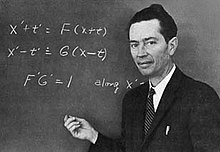Robert T. Jones
Robert Thomas Jones (born May 28, 1910 in Macon , Missouri , † August 11, 1999 ) was an American engineer . He was an aircraft engineer and aerodynamicist at NASA and its forerunner, the National Advisory Committee for Aeronautics (NACA).
Jones studied briefly at the University of Missouri , then joined an air show, where he trained with the help of NACA reports, and in 1929 developed a racing aircraft (Nicholas-Beazley Pobjoy Special). During the time of the Great Depression he had a job as an elevator operator in Washington, DC , but continued his education and made contact with the aerodynamicist Max Munk , whose evening classes at Catholic University he attended. In 1934 he was able to get a temporary position at the NACA's Langley Research Center in Hampton as part of the New Deal's job creation programs . In 1936 he was promoted to engineer (although he did not have a formal university degree). He stayed with NACA and its successor NASA and was later at NASA's Ames Research Center . In 1981 he retired and taught at Stanford University until 1987 .
At the beginning of the 1930s, he mainly dealt theoretically with the stability and control of aircraft. This had a great influence on the construction of the Ercoupe (1940) by its boss Fred Weick . From the 1940s he was mainly concerned with high-speed aerodynamics (supersonic) and, correspondingly, the flow of compressible liquids. In particular, in 1944 he came up with the idea of sweeping the wings at supersonic independently , in connection with the order for a theoretical analysis of a winged glide bomb developed at that time (he found that this was independent of the Mach number). The results were published in a 1946 NACA report. Similar ideas had previously been pursued in Germany ( Adolf Busemann ). Busemann gave a lecture about this as early as 1935 (which, however, received little attention in the USA at the time because supersonic flight seemed unrealistic at the time) and his attempts in World War II were also known in the USA after the war. But Jones came up with the same idea independently.
From 1963 to 1970 he was not at the Ames Research Center, but dealt with the hydrodynamics of the bloodstream at the Avco Everett Research Laboratory in Massachusetts. An artificial heart and other medical applications were developed there.
He also published on relativistic kinematics and reflector telescopes - in the 1950s he built his own telescope, which he sold in his own company. He also built his own violins when his daughter became a violinist. In the mid-1980s he acquired a pilot's license and flew in his own machines (such as an Ercoupe).
In 1986 he received the Hydrodynamics Prize of the American Physical Society , was a Fellow and later an Honorary Fellow of the American Institute of Aeronautics and Astronautics (AIAA), received the Ludwig Prandtl Ring in 1978 , the Langley Gold Medal of the Smithsonian Institution in 1981, and the Sylvanus in 1946 Albert Reed Award from the Institute of the Aeronautical Sciences and received the Aeronautical Engineering Award from the National Academy of Sciences in 1990. He was a member of the National Academy of Engineering , the American Academy of Arts and Sciences (1973) and the National Academy of Sciences (1981). In 1971 he received an honorary doctorate from the University of Colorado.
Fonts
- Aerodynamic Design for Supersonic Speed , in: Proc. International Congress Aeronautical Sciences, Volume 1, Volume 1, Pergamon Press, 1959, pp. 34-51
- with Doris Cohen: Aerodynamics of wings at high speeds , in AF Donovan, HR Lawrence Aerodynamic components of aircraft at high speed , Princeton University Press 1957, pp. 3–243
- Wing theory , Princeton University Press 1990
- Recollections from an earlier period in american aeronautics , Annual Review of Fluid Mechanics , Volume 9, 1979, pp. 1-11
- Collected works of Robert T. Jones, NASA 1976
Web links
| personal data | |
|---|---|
| SURNAME | Jones, Robert T. |
| ALTERNATIVE NAMES | Jones, Robert Thomas |
| BRIEF DESCRIPTION | American engineer |
| DATE OF BIRTH | May 28, 1910 |
| PLACE OF BIRTH | Macon , Missouri |
| DATE OF DEATH | August 11, 1999 |
